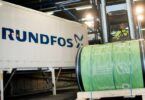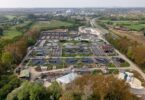Plastics got us to the moon, brought huge advancements in medicine and transformed the manufacturing industry.
But the characteristics that render plastics so useful, also make them an environmental nightmare. The biggest culprits are single-use plastics – think straws, wrappers, bags and bottles.
Approximately 50 billion water bottles are purchased each year in the U.S., 80% of which are not recycled. Producing these bottles emits huge amounts of carbon and, once disposed of, pollutes the environment.
According to Manuela Zoninsein, founder and CEO of Kadeya, part of the reason why consumers purchase so many single-use water bottles – 13 per person per month on average – is convenience.
Kadeya is a Chicago-based startup that aims to make hydration both sustainable AND convenient, using smart technologies.
We caught up with climate tech entrepreneur and founder Manuela Zoninsein to find out more about the company and her zero waste water mission.
What inspired you to start Kadeya?
I come from a family of immigrants from Brazil and from a young age I learnt to be resourceful – to reuse materials, turn off the lights, save water, and fixed what I had.
After college I moved to China where I lived for 8 years. In that timeframe I witnessed the country’s transformation from a very sustainable, reuse oriented system, to a single-use, linear economic model.
I thought to myself, if each person in China is using single-use plastics and there are 1.4 billion people in the whole country, then this is an environmental catastrophe waiting to happen. And if you zoom out to a global scale, then the enormity of the problem becomes clear.
That was my ‘light bulb’ moment, and I started to think about how to restructure the motives and incentives around water bottle consumption.
When I moved back to the United States, I started working for Palantir Technologies and got to travel all over the world, and the one thing I noticed was that there was a fridge full of single-use plastic water bottles in every office I went to. Without exception.
So I thought to myself: what is motivating people to continue to buy single-use plastic water bottles?
I collaborated with the kitchen staff at my own office at Palantir, to develop a reusable water bottle programme. The kitchen staff would wash them overnight, put them back at the dispensing counter, and then the employees would fill up their water again in the morning.
But after a couple of years, the initiative failed.
This sparked an intense drive within me to find out why. During my time at MIT Business School, I conducted hundreds of interviews with office managers and employees which drew the conclusion that the age-old saying ‘convenience is king’ still holds true.
If you are going to compete with single-use plastics you need to adopt a ‘grab and go’ model – hence why I founded Kadeya.
Why is Kadeya a game changer?
Kadeya is a fully circular water bottle programme that is as convenient as single-use but with a much lower carbon footprint. Our glass bottles reduce carbon emissions against PET plastic by 64% and aluminium by 67%.
We have stations that act as water refilling and purchasing vending machines, similar to a bike sharing platform in most cities. But instead of bikes moving between stations, its bottles. The machines can receive, sterilise, refill, and cap a glass bottle for reuse all within the station itself.
Each user has a unique QR code. You can have this on your phone or work badge and just scan it at the vending machine and within 3 seconds comes out a bottle of prefilled, filtered, and chilled water. That’s faster than opening and closing a fridge door.
Every bottle has a laser sketched code engraved on the surface so we can track who has which bottle and whether it has been returned or not. When you are done drinking the bottle you bring it to any station in the network, we rescan it, and then the station refills it for the next consumer.
Our app can tell you not just how much water you consumed, but also your carbon footprint reduction. We are the first business to market that digitises hydration, in the same way that you can monitor your steps, your heart-rate, and your sleep.
In the future we want to integrate this data with fitness apps such as FitBit, AppleWatch, and Tonal. All of these platforms want to give you a full overview of your health but none of them know how much water you are consuming.
How do you keep people coming back?
In our first pilot last year we had a 100% return rate from all of the users. Their feedback was that they value the bottle because its glass, not plastic.
We also found through research that if you have a way of identifying the individual and following up with them they are far more likely to return the bottle, and we only give you your consumption and carbon reduction stats once the bottle is returned.
As we grow, if people do leave behind bottles we want to use that data to inform where we need to put more stations next. Because we can contact the person who didn’t return the bottle, we can find out why, and identify if there is a particular place that really needs a station.
That data is really valuable and is what makes the digital component of our design so important.
What are your hopes for the future?
Currently our Alpha prototype is completed, it’s about 60% autonomous, and we are getting ready for two pilots in Chicago.
Our mission is to disrupt unsustainable supply chains by building an interlinked circular network where materials are infinitely reused.
Our future vision is an all-in-one water filling and sterilising machine, and our brilliant R&D team is currently hard at work in the lab developing our Beta prototype which will be a 100% autonomous.
Watch this space!







